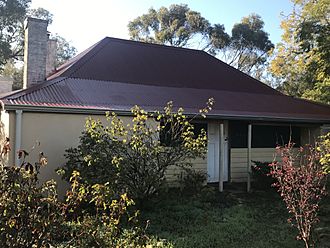Eliza's Cottage facts for kids
Quick facts for kids Eliza's Cottage |
|
|---|---|

Eliza's Cottage in 2018
|
|
| Alternative names | Lookout for Trains Cottage, Burtons Cottage. |
| General information | |
| Address | 9 Revett Place |
| Town or city | York, Western Australia |
| Coordinates | 31°53′55″S 116°46′09″E / 31.89864°S 116.7692°E |
| Construction started | c. 1840 |
| Type | State Registered Place |
| Designated | 5 January 2001 |
| Reference no. | 2868 |
| References | |
| York municipal inventory | |
Eliza's Cottage is a very old and special house located in the York area of Western Australia. It's known for its unique history and how it was built, making it an important part of the area's heritage.
Contents
History of Eliza's Cottage
Eliza's Cottage has grown and changed over many years. It started as a small home and was added to several times, showing how building styles and needs changed over nearly two centuries.
Early Beginnings: The 1840s
The oldest part of the cottage, just two rooms, was likely built around the early 1840s. At that time, the land belonged to someone named Bland. We don't know for sure who first lived in the cottage, but it might have been Bland himself or workers on his land.
New Owners and Major Changes
In 1855, the land was sold to Stephen Stanley Parker. He might have lived in the cottage for a short time before building a larger house nearby called Bridge House.
Henry Burton's Time
In 1860, Parker sold a piece of the land, including the cottage, to Henry Burton. Burton had arrived in Western Australia in 1850. He was a "pensioner guard," which means he was a former soldier who had retired and was sent to Australia to help guard convicts. Records show he was a labourer living in York.
A Carpenter's Improvements
Burton sold the cottage in 1870 to Harden York, who was a "victualler" (someone who sold food and drinks). York later moved away and sold the cottage in 1874 to Thomas Tomkinson, a carpenter from York. Tomkinson owned the cottage for nine years. When he sold it in 1883, the price had gone up a lot, from £40 to £120! This suggests that Tomkinson, who was described as a builder by 1883, likely made big improvements or additions to the house himself.
More Owners and the Cottage's Name
After Tomkinson, the cottage had several owners who bought it more as an investment than a place to live. In 1901, William Cox, a "teamster" (someone who drove teams of horses or oxen), bought the cottage. However, he couldn't keep up with his payments, and the property eventually went to Mary Neville, who had lent him money.
The cottage continued to change hands over the years. In 1988, Michael and Alice Woods owned it and added more rooms to the back. Finally, in 1991, Bruce and Kathleen May bought the house. They were the ones who gave it the name Eliza's Cottage.
Architecture of Eliza's Cottage
Eliza's Cottage is a great example of how buildings were constructed in the early days of settlement in the York area. It's special because its oldest part was built using a method called "rammed earth."
Building Materials and Style
The cottage is a simple, single-story building in the "Victorian Georgian style." This style was popular in the Victorian era and often featured balanced, simple designs.
- Original Core: The very first part of the house, the two central rooms, was made from rammed earth. This is an old building method where damp soil is packed down tightly between temporary frames to create strong walls.
- Later Extensions: Over time, soft bricks were used to build extensions around the original rammed earth rooms. This means the older, unique rammed earth structure is now completely surrounded by these later additions.
- Recent Additions: The newest parts at the back of the cottage are made from harder, modern bricks.
- Exterior Look: The outside of the cottage has been covered with a smooth layer called "render," which protects the walls and gives it a neat finish.
- Roof and Chimneys: The roof is a "hipped roof" (sloping on all sides) and is covered with corrugated iron. Three simple brick chimneys stick out from the roof on the northern side.
Why Rammed Earth is Important
The use of rammed earth in the 1830s and 1840s helps historians guess when Eliza's Cottage was first built. It was a common and practical way to build homes in those early settlement years. It's rare to find such an old rammed earth structure still standing and preserved within a larger building today.

